The vast majority of Black Virgin Madonnas have performed miracles and are sort after for a miracle or pray.
Some cured the plague, others have stopped drought, cured illness, facilitated infertile women to bear children, restored eyesight, and these are just a few of the countless examples of her miracles.
In history, the location where a statue’s first miracle was performed became her sanctuary and later where a church was built in her honour.
Interestingly, there are examples of incidents when others ( usually the clergy) had a better idea of where they wanted her to be, relocating where she was to be honoured. Yet, she would disappear and reappear where her original site was. Most people would give up “trying” to relocate her and embraced her original sacred site and there her sanctuary would be built and there it remained.
Below we will endeavour to document miracles known to a particular Black Madonna, yet they are too many to document. Even as early as 1172, a book of her miracles was written – Livre des Miracles – Book of Miracles.
The Black Virgins of France and their miracles.
We only really need to look at a few examples to realise how the Black Virgin story emerged or transformed from the pre-Christian goddesses to the statues we see today.
Their story is a Christian one of integration, incorporating the pilgrim’s acceptance of early Christianity.
By the 14th century CE old pagan religions were exiled, but they never went away in their entirety.
Pagan symbols and rituals like carnivals, singing, the halo and the important Christmas tree (as we call it today) show us that an integration took place.
Notorious Pope Gregory the Great in 600 CE wrote
“that the killing of oxen during the pagan rituals should remain the same, allow then to build foliage structures around our church, only then will you lead them more easily to our spirit”.
And so, we can see how our 7th and 9th century CE statues transformed into the statues we see today.
However, their purpose and their gifts of healing, peace and faith has not diminished, with time, her presence has only grown their loyalty and popularity.
Let’s have a look at a few Black Virgins and see for ourselves.
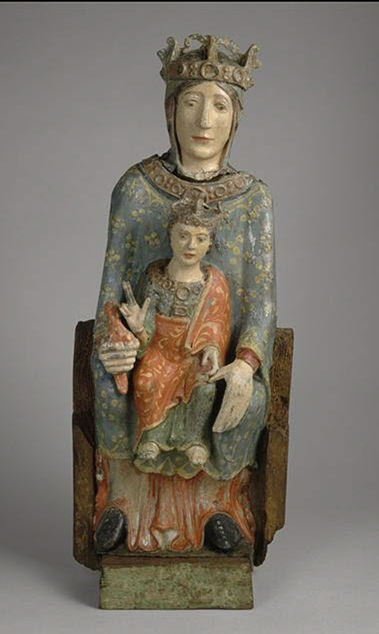
Firstly, let us consider Our Lady of Baroilles from Saint-Georges-de-Baroilles , the Loire area, France.
She is 12th century CE polychromed and is 52 cm in height and fits the classic pattern of a Black Virgin.
Not much is known of her beginnings and how she came to be, but the Louvre Museum purchased her in 1952 where she sits today behind glass.
A hint of her blessings to us is indicated with her carrying a dove, a symbol of peace and beauty. It also reflects her being a messenger from the gods.
We include her here to show that not only can you sit in contemplation in a church with our Black Virgins, you can also receive her messages even behind glass in a museum.
Virgin in Majesty called “Notre-Dame de Baroilles”
Place of origin: Chapel of Our Lady of Baroilles (France->Saint-Georges-de-Baroilles)
Source: Lourve
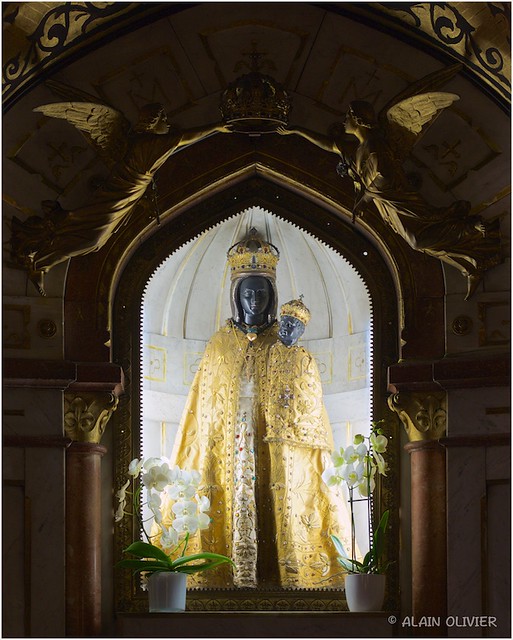
Another legend from published history is of Our Lady of Myans located on a little hill between Modane and Chambery.
She was an object of the devotion of Saint Francis de Sales. Yet, she became known for her miracles, in particular one in 1248.
On November 24th, 1248 CE a disastrous landslide occurred when part of the mountain Granier collapsed, and an estimated 150 million meters of rock broke away and descended on the city of St. Andrew and sixteen villages in Savoy France.
An estimated 4000 people were killed, and the villages were wiped out – except for the village of Myans.
Our Lady of Myans
Source: anastpaul.com
The town was almost entirely submerged, except for the small church. It inexplicably and miraculously remained untouched by the landslide.
Historians will tell you that the village was located on the higher slope, and the church even higher and that is why it survived.
Folklore maintains that the church was saved because the villagers were in the church praying with the Black Virgin.
It is said that their worship and faith of Our Lady of Myans saved them.
She is still there today. She is called l’Image de Notre Dame en Ethiopian, the Image of Our Lady Black in Ethiopian.
She resides in the crypt, and is 70 cm in height, and is known to be from 1100CE.
The church is called Our Lady of Myans and, what you first notice now, is a golden modern Madonna on top of the belfry.
It is reported that the Black Virgin of Myans has performed many other miracles often gifted to save someone from a natural disaster or drowning.
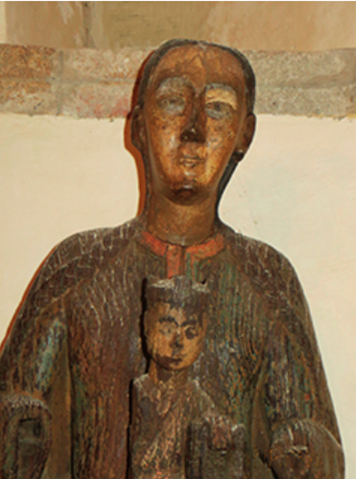
Our Lady of the Assumption, Espira de Conflent is a very old statue, in fact one of the oldest, from the 10th century CE.
The Black Virgin is Romanesque and is said to be blessed.
When you gaze upon her, you may think her to be a man, yet the long braids of hair show that she reflects the Divine Feminine.
Her miracles relate to the fountain water that sits in front of the church.
In 1080 CE, the church was managed by the Augustinian monks. While the fountain was usually abundant with water, sometimes it was not and there was no water for pilgrims.
It was known that if you prayed to the Black Virgin, she would make the water flow for all the pilgrims to drink.
Our Lady of The Assumption Church – Espira de Conflent
Source: www.baladesromanes66.net
The original home of Sancta Maria de Coral, as she is called, was in the town of Miralles, in the Pyrenees.
After a time, the 9th century CE church in which she resided, was abandoned due to the Islamic wars.
An unknown person placed her in an old oak tree where she lay hidden for centuries.
She was found by a herdsman who said that his bull wouldn’t stop mooing in front of the tree.
She was taken to a neighbouring village where she performed miracles.

Her devotion grew, as did the town, and a new church was built over the old one which dated 1267CE.
It’s at this point that our Black Virgin was painted white, and pilgrims began to congregate.
In the 1800 CE, after the revolution, she was sold off to a group from Prats-de-Mollo where they kept her cult worship alive in the church bearing her name.
Her miracles are identified as curing leprosy, urinary tract problems and anything related to water. Often treatments were required involving taking a nice dip in the nearby healing waters in Southern France.
Notre-Dame d’El Coral, Our Lady from the Heart of the Oak
Source: Interfaithmary.net
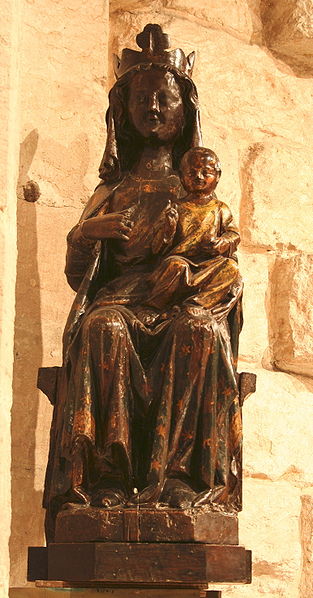
Notre Dame de Confession is the ancient Black Virgin of Marseille.
Legend says that she was carved by St Luke for Lazarus from fennel wood with an unknown year and she sits at 98 cm in height.
Archaeology tells us that she is carved from dark walnut and is from the 13th century.
Services to her are held in the catacombs of the church Saint Victor de Marseille.
Notre Dame de Confession
Source Commons-Wikimedia
She holds a staff, and she wears a crown.
She is known for miracles gifted by the raw earth. All plant growth is blessed by the burning of green candles, securing an abundant spring harvest.
Thus, a very special type of worship and devotion has been strongly established, symbolised with alot of green.
Author Ean Begg explains a misunderstanding from an old interpretation of ancient dialects where Our Lady was originally called by another name: ‘Our Lady the Green One’.
She also was called ‘Our Lady of the New Fire’.
This has come about because on her feast day, which Ean Begg says is February 2nd, called Candlemas, new wicks and lamp oil and green candles are blessed. This is done both in the church and in homes. Most home in the district have a picture of her somewhere in the house and pray to her for birth growth and nature
Also on her day of celebration, bread is baked in the shape of boats ( barque of Isis pastries navettes). This is to celebrate the landing of Mary Jakobe, Mary Salone, Magdalene and Sarah at St Marie’s by the Sea (for more on this view our virtual tour St Marie’s by the Sea).
She is called Notre Dame de Confession because her original form in the crypt was said to watch over the tombs of the martyrs from 416 CE. Even today we see many sarcophagi from Egypt. She also has a deep connection to Saint Sarah.
Residing with her is a second statue called ‘Our Lady of Wisdom’.
She is made from chestnut wood and is more modern. She has baby Jesus giving a right-handed blessing.
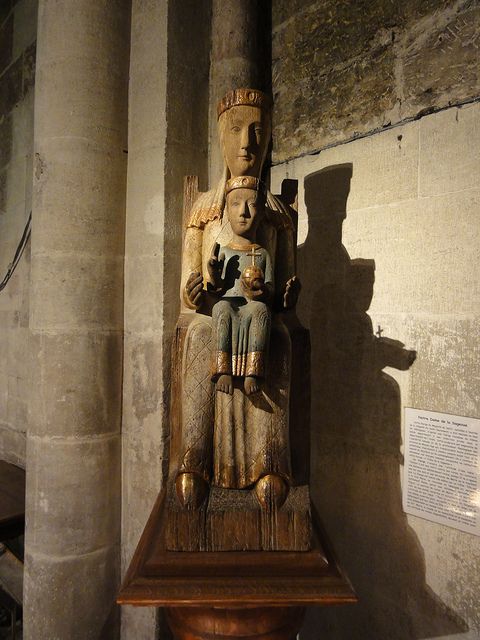
Our Lady of Wisdom
Source: Pinterest
The story of the Black Virgins and their resurrection appear in many different forms.
Most often the statue is discovered in trees, brambles, bushes, in a lake, a spring, fountain and rivers. Water is a vital element in her narrative as are trees.
Another favourite is how cows and bulls stand in spots where Black Virgins have been buried or hidden in nature. Shepherds take notice of the cow’s actions, they find the statue, take it too the local bishop, where she is place within the parish and like magic the statue would vanish back to her original place. This storyline will happen countless times until a decision to build a chapel to her on her discovery location.
This importance of where the Black Virgins are found indicates that the space and the place were of great importance to the pilgrim’s route. These in situ objects were to permit ordinary people to have experiences daily in faith and devotion and have a far closer contact with the Divine.